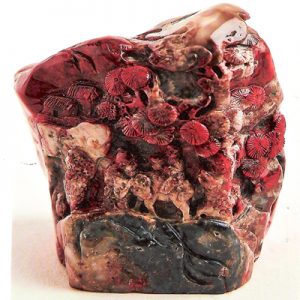Myrickite
Myrickite is mixture of Quartz or Chalcedony material containing spots or bands of red Cinnabar, yellow Calomel (mercury chloride) and black Metacinnabar. The name Myrickite is a lapidary term, not a mineral name, and is used for both agatized and opalized material containing Cinnabar. It typically has a white, pale yellow or light to dark gray background color with vivid spots or banding of orange to red Cinnabar and black Metacinnabar. It is reported from one source that Myrickite was named by D. B. Sterrett in 1912 for Francis Marion “Shady” Myrick, a prospector and miner, who found the material in 1911 somewhere in the California desert. However, another account suggests that Myrickite is named for an occurance of the material from an area about two miles northeast of Myrick Spring, San Bernardino County, California. It’s possible both the material and the spring are named after Shady Myrick. The story behind the nickname “Shady” is that when he was a young prospector, he was persistent in asking a couple old timers where he might find silver. One of them casually told him to go dig under a nearby tree. After digging for a while in the shade of the tree, to the dismay of the old timers, Myrick actually found a small silver vein. So the nickname “Shady” Myrick stuck.
Myrickite has also been found at other locations in California. During the early 1950s, Myrickite was found in small quantities at the Manhattan Mine, Napa County. Other occurances of Myrickite in California are: Death Valley, Inyo County; Soledad Mountain, Mojave District, Kern County; Lead Pipe Springs, San Bernardino County; Riconada Mine, San Louis Obispo County; and the Tilton Ranch, Santa Clara County. There are also occurances at these locations outside of California: at several locations in the Mazatzal Mountains, Gila and Maricopa Counties, Arizona; the Yellow Pine District, Valley County, Idaho; Beatty, Nye County, Nevada; and Morton District, Lewis County, Washington.


